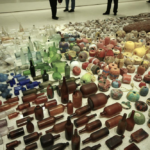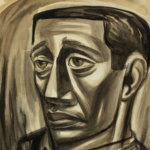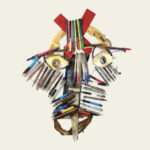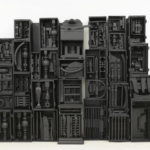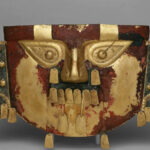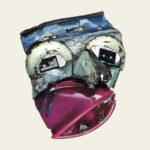Overview
In this unit, students will explore creating expressive face sculptures using everyday materials. They will learn about found objects and assemblage sculpture as expressive art forms, developing techniques and skills for sculpting while becoming more attuned to the materials around them.
Lessons
Materials and Tools
- Found household objects
- A piece of paper or cardboard
- Scissors
- Collected objects
- Transformed objects
- Materials for attaching
Alternative Materials
If zip ties are not available for students to use to attach materials, any of these can be substituted:
- Wire twist ties that come with bread
- Pieces of wire
- Tape
- String
If paint is not available for students, encourage them to find materials with similar colors such as cardboard/packing materials.
Objectives
- Students will find and collect a variety of materials and experiment with attaching them together
- Students will transform and arrange materials to convey meaning and explore facial expressions
- Students will document their work to compare and contrast each experiment
Student Outcomes
Students will understand that:
- Selection is a powerful tool of expression that demonstrates preferences and identities
- By arranging and rearranging materials, multiple meanings can be explored
- Artists evoke emotion through their use of materials
Students will be able to:
- Gain sensitivity to materials and identify uses for them beyond their original functions
- Demonstrate how to change the meaning of objects within different contexts
- Apply knowledge about materials, attachment strategies, and transformation to create expressive faces using nontraditional materials
Resources
Metropolitan Museum of Art
Siah Armajani: Follow This Line exhibition overview:
https://www.metmuseum.org/exhibitions/listings/2019/siah-armajani-follow-this-line
Museum of the City of New York
New York City skyscraper lesson
Imaginary Playgrounds
A playground equipment system that is made for building
Adaptations
For Students with Disabilities
- Modify material and tool choices: offer two to three simple ways to attach different materials. Consider offering tape, glue, Velcro, or other easily managed options
- Ask students to make choices and facilitate technical processes with them
- Use technology such as an iPad or Google Classroom for students to manipulate photos of objects, experiment with planning a sculpture, or make a digital collage instead of a three-dimensional sculpture
- Use audio with visuals in the student-facing Google Slides
For Multilingual Learners
- Emphasize repetition of new art vocabulary. Spiral new art concepts and vocabulary
- Activate students’ prior knowledge
- Use images of techniques paired with vocabulary words to help with meaning
- Chunk information and keep instructions concise
- Have multiple entry points: speak, show, and do
- Use audio with visuals in student-facing lesson guides
- Pre-teach vocabulary and concepts (see content-specific vocabulary)
- Signpost: give clear directions for each step, and let students know what comes next
- Use different modalities such as sound and movement. For example, create a voice for the different facial expressions that students create
Extensions
Memory and Assemblage
Joseph Cornell: https://americanart.si.edu/artist/joseph-cornell-995
Students explore assemblage sculpture with an emphasis on memory. Students work with found personal materials and photos to explore personal history. If no photos are available, students can work with sketches.
Exploring the Readymade
Marcel Duchamp: https://www.theartstory.org/definition/readymade-and-found-object/history-and-concepts/
Students learn about the history of the Readymade and the artist Marcel Duchamp. Students focus on assemblage sculpture by combining/transforming manufactured objects. Students could be tasked with transforming two mundane objects from a dollar store by combining them.
Exploring Monochromatic Assemblage
Louise Nevelson: https://www.tate.org.uk/art/artists/louise-nevelson-1696
Students create a monochromatic assemblage of found materials inspired by the artist Louise Nevelson that inspires an awareness of shape, line, texture, and composition as well as color as a unifying principle in design. If paint is not available for students, encourage them to find similarly colored materials such as cardboard/packing materials.
New York Teaching & Learning in Visual Arts Standards
Art Making: 8th Grade Learning Indicators for Sculpture
Create a sculpture that demonstrates:
- Attention to scale
- Unity through purposeful selection and manipulation of materials such as clay, plaster, paper pulp, wire
- Expressive use of texture and form
- Inventive organization of positive and negative space
- Symmetrical/asymmetrical balance
Literacy in the Arts
- Looking at and Discussing Art
- Developing Visual Arts Vocabulary
- Reading and Writing About Art
- Problem Solving: Interpreting and Analyzing Art
Making Connections
- Recognizing the Societal, Cultural, and Historical Significance of Art
- Connecting Art to Other Disciplines
- Observing and Interpreting the World
Community and Cultural Resources
- Cultural Institutions
- Online Resources and Libraries
- Community-Based Organizations (CBOs), Local Artists, and Studios
Careers and Lifelong Learning
- Awareness of Careers in Visual Arts
- Art for Enjoyment and Lifelong Learning
NYS Learning Standards for the Arts
Artistic Process: Creating
Anchor Standards:
- Anchor Standard 1: Generate and conceptualize artistic ideas and work
- Anchor Standard 2: Organize and develop artistic ideas and work
- Anchor Standard 3: Refine and complete artistic work
Artistic Process: Presenting
Anchor Standards:
- Anchor Standard 4: Select, analyze, and interpret artistic work for presentation
- Anchor Standard 5: Develop and refine artistic techniques and work for presentation
- Anchor Standard 6: Convey meaning through the presentation of artistic work
Artistic Process: Responding
Anchor Standards:
- Anchor Standard 7: Perceive and analyze artistic work
- Anchor Standard 8: Interpret meaning in artistic work
- Anchor Standard 9: Apply criteria to evaluate artistic work
Artistic Process: Connecting
Anchor Standards:
- Anchor Standard 10: Relate and synthesize knowledge and personal experiences to inspire and inform artistic work
- Anchor Standard 11: Investigate ways that artistic work is influenced by societal, cultural, and historical context and, in turn, how artistic ideas shape cultures past, present, and future
Credits
Writing Team
Nick DeMarco, Jamie Powell, Robin Holder, Tim Thyzel
Project Team
Belinda Blum, Nicola Giardina, Paul Urevitch, Andrea Burgay
Studio in a School NYC Team
Julie Applebaum, Senior Director
Hasna Muhammad, Ed.D., Chair, Board of Directors, Studio in a School Association
Alison Scott-Williams, President, Studio in a School NYC
NYC Department of Education OASP Team
Karen Rosner, Director of Visual Arts
Amber Lodman, Arts Program Manager
Kaitlin Trammell, Remote Arts Learning Partnership Project Coordinator
NYC Department of Education Visual Arts Teacher Team
Maria Bonilla, Amie Robinson, Susan Bricker, Lara Tyson
These educational materials were created through a partnership with Studio in a School NYC and The New York City Department of Education Office of Arts and Special Projects (OASP) and made possible by the generosity of The New York Community Trust.
Copyright © 2023 Studio in a School NYC LLC


